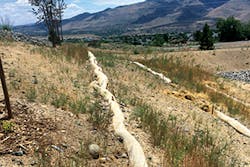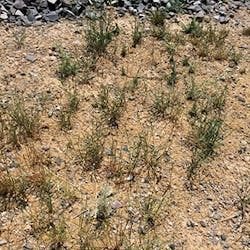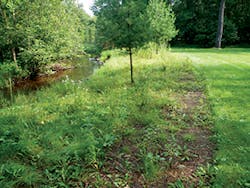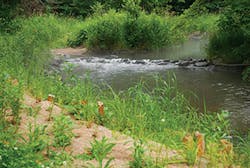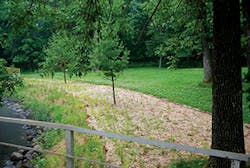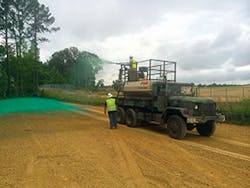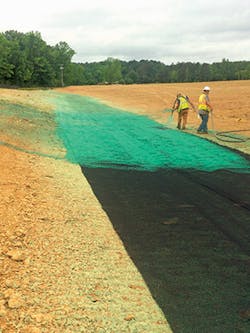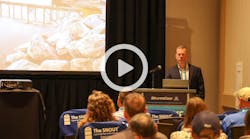Julie Etra’s approach to the erosion control work her company does is simple to describe. It isn’t always easy to accomplish, though.
“You shouldn’t know we were ever there. [The work is] so good that it matches what was there before,” explains Etra.
Making a newly established section of ground match an existing part of a property or roadside takes skill and knowledge. Etra has both, and enthusiasm for her work. In the last couple of years she has branched into designing and evaluating erosion control projects through her company, Western Botanical Services, in Reno, NV.
One of Etra’s challenging projects was controlling erosion on the steep slopes of the Church of Latter Day Saints (LDS) in Reno. The church needed to stabilize the slopes and control stormwater runoff. The project, which covered about an acre and a half, began in August 2014 and was finished in October.
“The site faces south and it’s very windy, up on a hill. The Mormons usually put their temples in prominent spaces [like this one],” says Etra.
“The soils are really crummy. They are diatomaceous earth, so there are a limited number of plant species that will grow there,” she adds.
She characterizes the plants she selected for the project as native to a salt desert scrub community, or Great Basin scrub species. “I used only one non-native grass,” she says.
The plants included yarrow, Indian rice grass, milkweed for the butterflies, lupin, bottle brush grass, and squirrel tail grass. The dominant shrubs were sage brush and rabbitbrush.
“I used annual wild rye as a nurse crop,” says Etra.
Profile Products’ ProMatrix was used on this project. The bonded fiber matrix was applied in two passes. “It goes down at a heavy rate, a total of 4,000 pounds per acre,” says Etra. The first pass needed to be light because the shrubs “need UV light to germinate. We let the seed sit on the surface and the ProMatrix held it there,” explains Etra.
The slopes were prewet before the hydroseeding began. The first pass also included fumic acid (a soil amendment) and a mycorrhizal fungus.
“Ninety-five percent of our plants have a relationship with this fungus. It gets into the root of the plant, resulting in a great uptake of nutrients and water,” says Etra.
Etra also installed biodegradable sediment logs, made of rice straw encased in burlap, before the hydroseeding. “They’re three times as expensive as nonbiodegradable ones,” she notes. “Coconut-fiber logs are very dense, very heavy, very expensive. I didn’t need anything that heavy.”
Erosion control blankets were not used because the ground was so dry. “We only use blankets where there is some flow, such as a channel. We use wood chips or pine needles,” she explains.
Sometimes she has to explain to clients that in their part of the country, a quick regrowth of thick green grass is unrealistic. Taking the long-term approach with native plants is best. “I tell them that if you’ve got a seedling of a native plant the growth is there, below the ground. We’re in a drought, and it’s naturally arid here. To use drinking water [for irrigation] is a bad use of resources. We do our best job to jump start [the plants] and let nature take its course,” says Etra.
Skipping irrigation and focusing on native plants means that “it will be three or four years, more like five, before the site recovers completely,” she adds.
Assessing the project almost a year later, says Etra, “There’s been no erosion, and the plant community is coming back. The clients are happy because the city is happy.”
Slope work near the LDS temple in Reno, NV
Fritz Loven Park
Located in Cass County, the town of Lake Shore, MN, has a year-round population of about 1,400. Lake Shore is a magnet, though, for visitors seeking summer recreation on the water, because the town is close to several lakes.
Lake Shore also has Fritz Loven Park. The park’s 80 acres of land were acquired by Fritz Loven in the early 1930s. Loven was known as a genial man who lived simply—no running water, no electricity, no car—and welcomed fishermen and other visitors to his beautiful wooded property.
He wanted the city of Lake Shore to acquire his property after his death so that residents and visitors could continue to enjoy it. After the city bought the property from Loven’s sister, it became part of the Minnesota Land Trust, making it safe from future development.
Loven had planted about 400 trees by hand each year. The balsam, fir, pine, spruce, and other evergreens he planted have grown into a beautiful forest.
Running through the property is Stony Brook. This tributary of Gull Lake is a state-designated trout stream. Over the years, Stony Brook’s banks had eroded. Bank stabilization and shoreline restoration was needed. The collaborative effort involved members of the Lake Shore Environmental Committee, the Minnesota Department of Natural Resources (MNDNR), the US Army Corps of Engineers, the Conservation Corps of Minnesota and Iowa, and the Soil and Water Conservation Districts (SWCDs) of Crow Wing and Cass counties.
Although Stony Brook is located within Cass County, this was considered a watershed-wide project involving both counties. The two SWCDs have worked together on other projects and share resources.
“People picnic there, and there was no buffer to protect the trout stream. No structure was below the ground, just turfgrass that would have continued to erode,” says Beth Hippert, project manager for the Crow Wing County SWCD.
The project, which took place within the floodplain, was intended to stabilize the banks and improve fish habitat and stream quality. The area of shoreline restored was about 150 linear feet or 3,000 square feet. The work was done in June 2011.
Stony Brook in Fritz Loven Park, Lake Shore, MN, one year
after the project was completed
Some areas of the shoreline were left open and accessible so people who wanted to fly fish could walk close to Stony Brook, stand on its banks, and cast their lines. Path rush was planted in these areas. “It’s a tough rush that will stand up to foot traffic,” says Hippert. “We put in shrubs to keep people away from the shoreline in places that were less disturbed.”
She notes that challenges of the project included “finding the diversity of plants that would be a good buffer and could also withstand foot traffic and deer browsing.”
Native plants in the project included prairie blazing star, blue flag iris, false indigo, sneezeweed, porcupine sedge, Virginia strawberry, sweet flag, marsh marigold, red osier dogwood, black willow, sandbar willow, woodland phlox, monkey flower, and wool grass. About 2,500 native plants of 30 species and 1,500 grasses, rushes, and sedges of 18 species were installed. The work was done by agency staff members and volunteers.
Shoreline restoration work at Fritz Loven Park
The plants help stabilize the soil and also provide improved habitat for dragonflies, mayflies, and other aquatic insects the trout could feed on. Lunkers (shady overhangs where trout congregate) that the MNDNR had installed were enhanced.
Keeping people out of certain areas so that the plants could become established was also challenging. The existing small sign was replaced with a larger one, but by the third year it was necessary to add a fence.
“We took an ecosystem approach to prevent degradation of the stream and still allow people to use the paths to the water so they can fly fish,” says Hippert.
Fritz Loven Park
Erosion control products for the project were supplied by the Brock White Co., with locations in several Minnesota cities. Curlex I, an erosion control blanket from American Excelsior Co., was used, chosen for its specific cut of Great Lakes aspen curled wood excelsior. Eighty percent of Curlex I consists of aspen fibers that are 6 inches or longer, and the blanket is of a consistent thickness, with fibers evenly distributed throughout. The netting is photodegradable or biodegradable, and the blanket contains no weed seeds or chemical additives.
“I really like the Curlex. It holds the moisture in. The barbs of the aspen adhere to the soil. And it’s locally produced, so we don’t have environmental concerns [of using energy to transport a product made far away],” says Hippert.
Curlex NetFree, which is also made from Great Lakes aspen excelsior, was also used. “I never use any products with plastic photodegradable material, just cotton or jute,” explains Hippert. Then there’s no concern for the wildlife. They can chew their way out of cotton or jute.”
She adds, “This is a relatively flat area. We didn’t need double net. There’s no force because it’s a floodplain.”
Brock White also supplied the CoirMat 700 used, which is produced by RoLanka of Stockbridge, GA. The company specializes in coir products.
“The mat is right next to the stream. We rebuilt the earth and created a berm; it’s wrapped around the soil. It has much longer wear and can withstand the velocity of the stream. Three years later it’s still in place, but the Curlex has biodegraded [as it’s supposed to]. They’re helping hands to get the plants established,” says Hippert.
This restoration project will keep Stony Brook flowing clear and the trout plentiful. One person who worked on the project and came to love Fritz Loven Park was Caitlin Daudt, a dedicated young Crow Wing County SCWD intern. After Caity died in a traffic accident, her co-workers donated a bench in Fritz Loven Park in her memory.
Cleaning Up a Superfund Site
Some years after the American Creosote plant in Louisville, MS, closed, residents grew concerned about the quality of their drinking water supply. Investigation revealed that erosion was allowing contaminants to seep through the soil. EPA ordered a Superfund cleanup of the land.
Damian McKay’s company, Green Way Erosion Control, of Wiggins, MS, has been doing erosion control work on the project. The crew started in fall 2013 and is finishing up the work this year.
“We were stabilizing the top surface and we did some site work,” says McKay. “A Florida company, Core Engineering, did the subsurface work. They built a wall underground, a 70-foot-deep trench all around the site, and pumped it full of cement so nothing could leak out.”
Like many major erosion control projects, this one was done in phases, including temporary and permanent seeding. Green Way planted 60 acres of temporary grass, using brown top millet, Bermuda grass, and Bahia grass. After the site was stabilized with permanent soils, the company applied hydromulch and Bahia grass and Bermuda grass seed on about 40 acres.
Applying Flexterra at the American Creosote facility cleanup project in Louisville, MS
Part of the project involved stabilizing a 900-foot-long, 16-foot-wide ditch. McKay relied on the GreenArmor system, which combines Profile Products’ Flexterra flexible growth medium with Bonar’s Enkamat, a turf reinforcement mat (TRM).
“I put GreenArmor right up there with hard armor,” says McKay. “It’s one step below hard armor, but sometimes it does a better job than riprap and [other] hard armor.”
Green Way crew members also installed hard armor along a creek on the northwest side of the property where a creek bank had been washing out.
“We put hard armor, riprap, on the bank and pumped concrete in. Then we did basic seeding,” says McKay.
Maintenance work that will be done on the project will involve “some mowing and fixing washouts. We’ll probably do some Flexterra application,” says McKay.
He says the most challenging part of the American Creosote site project was getting the GreenArmor section exactly right. “You have to pay attention to your guide, put in enough staples, and get the mixture right,” he explains. “Enkamat is about one-half-inch thick. If the mixture is too thick, it could stick on top. It has to have enough liquid so it shoots down inside of the mat. You don’t want any air gaps.”
McKay also used GreenArmor on a project on the target berms of the bombing range at Camp Shelby, MS. He notes that while Enkamat can be used without the Flexterra, “in my opinion, you’re much better off using them together.”
American Creosote was a special project for McKay’s company because it was the first project involving the use of a drone. McKay sees drones as the next advance in erosion control work.
“There may be sediment in a creek. When you’re standing on the site you don’t see it, but a drone can fly up above before we start and show the sediment. We can do project updates and show a customer that the sediment was here before we began,” he says.
He notes that using a drone “gives you another perspective. You can do a video or still photos. It’s another tool in the toolbox. You can give clients a jump drive with the file [of their project] on it. Drones add value to our work.”
McKay sees a strong continuing need for erosion control work in the future. “I think with all the environmental concerns and regulations coming down from Washington that the erosion control business is here to stay.”
His only concern is with “engineers who spec material and don’t know what they’re spec’ing. It gives the whole industry a bad name when cheap materials and light spraying are done. That’s the old ‘spray and pray.'”
McKay says that when engineers tell him that hydroseeding doesn’t work, “I tell them that it does if you take soil tests, use the right mixture, the right application, and do it at the right time of year.”
Charlotte-Douglas International Airport
A major construction project took place at the Charlotte-Douglas International Airport in Charlotte, NC, from 2009 to 2011. Completed in several phases, this project included the extension of West Boulevard and the installation of 19,000 feet of steel water supply pipes.
Airport Drive is one route into and out of Charlotte-Douglas International Airport. With the water pipes going in along Airport Drive, it was a good time to perform additional work that would make the road safer.
CDM Smith, a Charlotte engineering firm, designed this part of the projects. John Lapsley, P.E., project manager for the company, worked on the project.
Airport Drive had a severe dip at the point where it crossed water. During severe rainstorms water could collect in that section of the road, hiding its depth.
“There was a detention pond on one side of the road and a receiving stream on the other side,” explains Lapsley. “Overflow stormwater from the detention pond flows into the receiving stream. A culvert pipe connects them beneath the road now.”
Applying Flexterra at the American Creosote site
Dirt was added to about a half mile of Airport Drive, elevating the road 15–20 feet. That process removed the dip, but the road now had very steep slopes on both sides, exceeding 2:1.
The desired mixture of bluegrass and fescue would not stay on these steep slopes long enough to germinate and produce the desired green result. CDM Smith engineers knew that a permanent erosion control measure would be necessary. They chose ECC-3, a triple-net TRM with a coir fiber matrix, manufactured by East Coast Erosion Blankets of Bernville, PA. The ECC-3 was installed after the slopes were graded and seeded.
ECC-3 is designed to provide permanent protection on 1:1 slopes and in high-flow channels. It can withstand shear stress of 3.7 pounds per square foot on unvegetated slopes and 12 psf on vegetated slopes. The coir-fiber matrix will slowly degrade in approximately 36 months as it is exposed to the weather and as the vegetation below penetrates through the netting.
The TRM was anchored at the top of the slopes along Airport Drive and allowed to unroll downward. Eleven-gauge steel staples that measured 6 inches were used to adhere the mat to the surface.
Now when travelers drive along Airport Drive, they move along smoothly on a level surface, with no slowing down for dips or standing water after heavy storms. Unless they were there a few years ago, they don’t realize that the road’s attractive green grass slopes control erosion and keep the road stable for safer driving.
